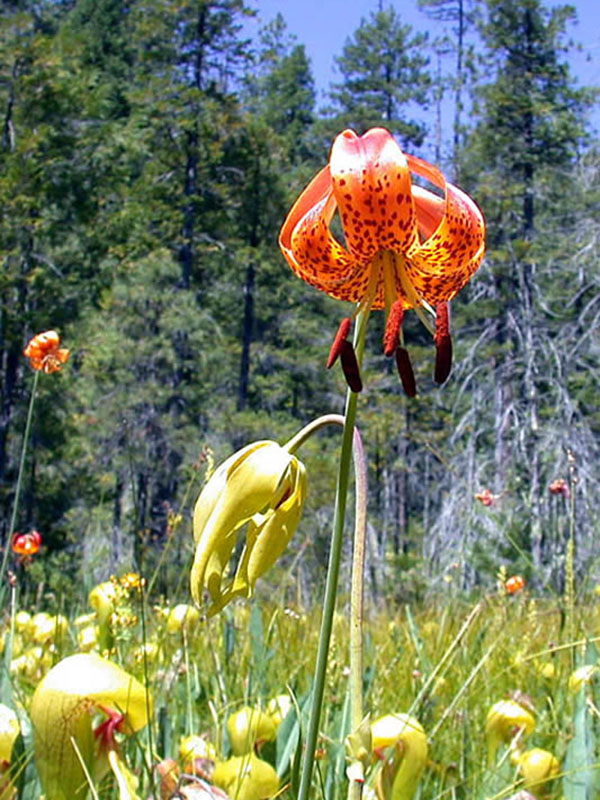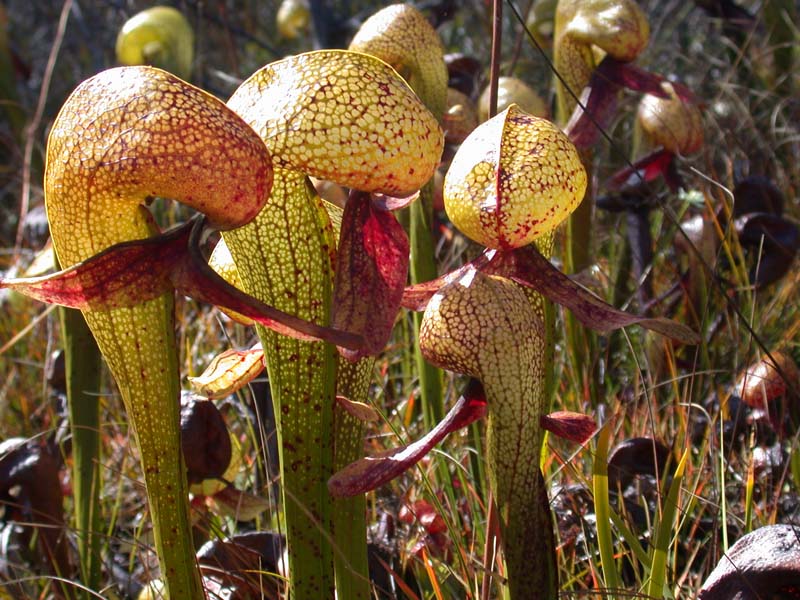Darlingtonia Wetlands, A Serpentine Classic
Darlingtonia californica (California pitcher plant) occurs in localized seeps, streamsides, or across broad terraces from the Sierra Nevada Mountains of northern California to the Klamath-Siskiyou Mountains of southwest Oregon. Darlingtonia can grow on or off serpentine, but as member of a plant community. Darlingtonia wetlands reach their greatest extent on serpentine areas of the coastal Klamath-Siskiyou Mountains where wetland complexes, called terraces, can extend over 10 acres.
 Hillslope Darlingtonia wetlands with California lady’s slipper (Cypripedium californicum) in the foreground. Photo by Jenny Moore.
Hillslope Darlingtonia wetlands with California lady’s slipper (Cypripedium californicum) in the foreground. Photo by Jenny Moore.
In this geographic area, Darlingtonia wetlands occur at an average elevation of 1,815 feet and on flat to moderately steep slopes. Of these wetlands, most range in size from ½ to 1½ acres. Water pH averages eight, which is on the basic end of the pH scale. High pH serpentine seeps and springs are the focal sites for research of microbial life, here and on other planets.
Hydrology is an important driver of these wetland communities. Variables related to geomorphic setting, water inflow and outflow, and water temperature provide for a diversity of plant communities. Hillslope springs, streamsides, and terraces are three broad categories of Darlingtonia plant communities.
Where hillslope springs occur, groundwater finds its way to the surface through fracture serpentine rock at sites subject to slumping. Streamside wetlands develop on gravel bars along stream channels. Terrace wetlands occur as a complex of seeps that run together on broad, low gradient slopes of former stream benches.
One and the Same
Darlingtonia wetlands and wet meadows overlap like a Venn diagram, i.e. some Darlingtonia grows in wet meadows and some wet meadows have Darlingtonia. Neither is completely a subset of the other. Read more…
Species assemblages and community structure likewise vary across the Darlingtonia wetland types. Streamside wetlands maintain a rocky to gravely substrate with high shrub and tree cover whereas high organic matter and a high cover of herbs and sedges characterize those wetlands of low gradient water flow.
Rare and endemic plant species array themselves across these broad community groups and are likewise correlated to variables related to hydrology, geomorphic gradient, and structure of vegetation. For example, the presence of Waldo gentian (Gentiana setigera) is correlated with high water flows, high grass/sedge cover, low shrub/tree cover, fine textured soils, and low to moderate slopes. Western bog violet (Viola primilifolia var. occidentalis) is associated with flowing water and high surface rock.
 Gentiana setigera. Photo by Norman Jensen, Photo·grafica botanii. Read more about G. setigera…
Gentiana setigera. Photo by Norman Jensen, Photo·grafica botanii. Read more about G. setigera…
 Lilium pardilinum ssp. vollmeri. Photo by Norman Jensen, Photo·grafica botanii.
Lilium pardilinum ssp. vollmeri. Photo by Norman Jensen, Photo·grafica botanii.
 Viola primilifolia var. occidentalis. Photo by Norman Jensen, Photo·grafica botanii.
Viola primilifolia var. occidentalis. Photo by Norman Jensen, Photo·grafica botanii.
Research Notes
Fire Recovery in Darlingtonia Wetlands
 Dr. Erik Jules records a GPS reading in the L. E. Horton Research Natural Area (Six Rivers National Forest) after the Biscuit Wildfire. Photo by Nate Sanders.
Dr. Erik Jules records a GPS reading in the L. E. Horton Research Natural Area (Six Rivers National Forest) after the Biscuit Wildfire. Photo by Nate Sanders.
In 2002, a lightning caused wildfire burned through the coastal serpentines of the Klamath-Siskiyous, burning up to 500,000 acres. Where there is fire, there is often the opportunity for research. What happens to the structure of plant communities after a fire? How do species or their abundances change? What other factors are affected that influence plant community recovery? Read more about fire recovery in darlingtonia wetlands…
Serpentinization and Microbial Processes in Alkaline Seeps and Springs of Ultramafic Rocks
 Dr. Dawn Cardace collecting water samples in a Darlingtonia wetland to test pH. Photo courtesy of Dr. Dawn Cardace.
Dr. Dawn Cardace collecting water samples in a Darlingtonia wetland to test pH. Photo courtesy of Dr. Dawn Cardace.
What do Darlingtonia wetlands and outer space have in common? A researcher from NASA is interested in finding out. Dr. Dawn Cardace is investigating the ancient subduction areas of the Klamath-Siskiyou Mountains, specifically their serpentine waters, for potential applications for life on other planets. Read more about Dr. Cardace's investigation…
Definitions
pH - pH is the concentration of hydrogen ions in solution. The higher the hydrogen ion (H+) concentration, the lower the pH. The lower the concentration of hydrogen ions, the higher the concentration of hydroxide ions (OH-) which equates to higher pH values.
pH measurements range from 0-14 with 7 being neutral. Measurements less than 7 are on the acidic end of the spectrum and those above 7 are basic or alkaline. Serpentine rocks, high in magnesium (Mg+), weather and release relatively high concentrations of Mg in the ground and surface water of serpentine areas. With the introduction of Mg+, the concentration of H+ is reduced, resulting in pH values above neutral.
Photo Gallery
Our thanks to CalPhotos and its many contributors for many of the pictures in this photo gallery.

Castilleja miniata ssp. elata. Photo by Norman Jensen, Photo·grafica botanii.

Cypripedium californicum. Photo by Br. Alfred Brousseau, College of St. Mary, California.

Darlingtonia californica. Photo by Maureen Jules.

Darlingtonia californica. Photo by Sherry Ballard, California Academy of Sciences.

Darlingtonia on the L. E. Horton Research Natural Area. Photo by Sydney Carothers.

Darlingtonia and peridotite. Photo by Sydney Carothers.

Gentiana setigera flower. Photo by Norman Jensen, Photo·grafica botanii.

Gentiana setigera. Photo by Norman Jensen, Photo·grafica botanii.

Hastingsia bracteosa var. atropurpurea. Photo by Norman Jensen, Photo·grafica botanii.

Hastingsia serpentinicola. Photo by Norman Jensen, Photo·grafica botanii.

Lilium pardilinum ssp. vollmeri. Photo courtesy of Six Rivers National Forest.

Lilium pardilinum ssp. vollmeri. Photo by Norman Jensen, Photo·grafica botanii.

Narthecium californicum. Photo by Dr. Dean William Taylor, Jepson Herbarium.

Pinguicula vulgaris ssp. macroceras. Photo by Norman Jensen, Photo·grafica botanii.

Raillardella pringlei. Photo by Julie Kierstead Nelson.

Rhododendron occidentale. Photo by Jenny Moore.

Rudbeckia californicum. Photo by Norman Jensen, Photo·grafica botanii.

Viola primulifolia ssp. occidentalis. Photo by Norman Jensen, Photo·grafica botanii.

Viola primulifolia ssp. occidentalis habitat. Photo by Evan Frost.
Resources and References
- Becking, R. W. 1997. The Darlingtonia bog communities of the Klamath Mountains northwest California-southwest Oregon. Pp. 1-7 in: Beigel, J. K., E. S. Jules and B. Snitkin, eds. Proceedings of the First Conference on Siskiyou Ecology, May 30-June 1, 1997. Coordinated by the Siskiyou Regional Education Project, Cave Junction, OR.
- Borgias, D. D. 1993. The hydrologic regime of serpentine fens on Eight Dollar Mountain, Josephine County, Oregon. Unpublished report, Oregon Field Office of The Nature Conservancy, Portland, OR. 8pp.
- Frost, E. J. and R. J. Sweeney and W. L. Bigg. 2004. Distribution and environmental/habitat relations of five endemic plants associated with serpentine fens in southwest Oregon and northwest California. Final report submitted by Wildwood Environmental Consulting, Ashland, Oregon, to the Bureau of Land Management, Medford Office, and the U.S. Forest Service Rogue River, Siskiyou, and Six Rivers National Forests.



